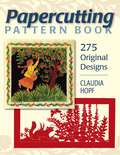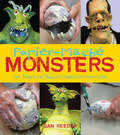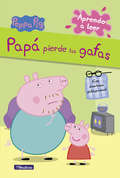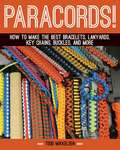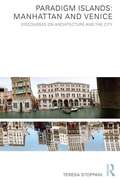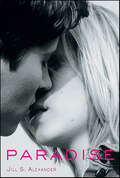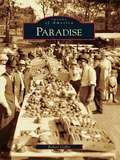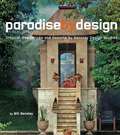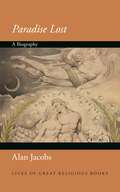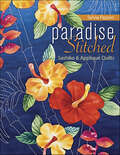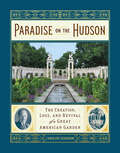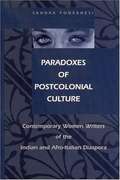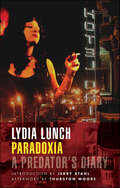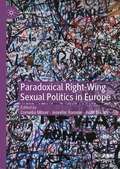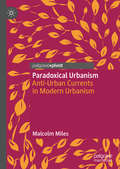- Table View
- List View
Papercutting Pattern Book
by Claudia HopfEasy-to-use patterns. All original designs. Tips for effective cutting.
Papercutting Through the Year
by Claudia Hopf• Easy-to-use patterns • All original designs • Christmas and Hanukkah • Valentine's Day, Easter, patriotic holidays, Halloween, Thanksgiving, and more • Zodiac signs and flowers of the 12 months for birthdays
Paperie: 100 Creative Papercraft Ideas
by Kirsty NealeA fresh, fun and contemporary book of 100 DIY paper projects with a modern, quirky twist! Paperie features a myriad of innovative ideas and easy-to-master papercraft techniques including clever ideas for unique stationery, home decor, cute paper jewellery, inspiring wedding ideas, upcycled gifts and one-of-a-kind accessories. Each of the techniques are accompanied by simple step-by-step instructions and diagrams - techniques include origami, stamping, stencilling, embossing, transfers, stitching on paper, collage, papercutting, decoupage, screen printing and papier mache. For those who can't wait to get started the tear-out pages at the back of the book offer stunning patterned papers and templates that you can use to create some of the projects right away! Here are some of the fab projects you can make: stationery items - envelopes, gift wrap, calendars and business cards, or stuff for parties - banners, garlands, badges, crackers and hats, puppets, or decor for the home - wall art, lighting, bowls, storage, vases, maps and birdhouses, even accessories - shoes, necklaces, spectacles and cufflinks, for weddings - pinatas, confetti, flowers and favors, or for those special gifts - mobiles, kites, pomanders, picture frames... and much, much more!
Papermaking with Garden Plants & Common Weeds
by Helen HiebertMake exquisite papers right in your own kitchen. With a few pieces of basic equipment and a small harvest of backyard weeds, you can easily create stunningly original handcrafted papers. Helen Heibert&’s illustrated step-by-step instructions show you how easy it is to blend and shape a variety of organic fibers into professional stationery, specialty books, and personalized gifts. You&’ll soon be creatively integrating plant stalks, bark, flower petals, pine needles, and more to add unique colors and textures to your paper creations. This publication conforms to the EPUB Accessibility specification at WCAG 2.0 Level AA.
Papier-Mâché
by Peter RushHow to work with papier-mâché, the variety of materials that can be used, and a short history of its craft.
Papier-Mâché Monsters: Turn Trinkets and Trash into Magnificent Monstrosities
by Dan ReederStep-by-step instructions for creating papier-mâché monstrosities and expanding the limits of your imagination, from the author of Paper Mache Dragons Celebrated monster-making master Dan Reeder is at it again—helping others to let out their inner monsters! All that&’s needed are a few simple materials and a wild imagination. Reeder guarantees success if the tried-and-tested, goof-proof how-to steps in this humorous read are followed. But there&’s more—he&’s also giving away all of his secrets for creating ghoulish monster elements such as jaws, claws, horns, scales, webbing, tentacles, eyeballs, fingers, toes, gnarly hands and feet, and even perfect drool! Learn how to make a basic monster and you&’ll be well on your way to creating more hideous creatures, beasts, dragons, and whatever else your dark side can think of!&“I&’m not one to argue that the world doesn&’t need more monsters, be they made of papier and/or cloth mâché, as demonstrated in Dan&’s entertaining new book, or flesh and blood, as demonstrated by the one standing behind you right now.&” —Gary Larson, creator, Far Side&“For lovers of the truly grotesque, Reeder provides detailed photo instructions for large figures constructed of clothes hangers, newspaper, and glue. Cloth skin, teeth, and slathered-on paint finish them off. The toothy dragons are particularly effective.&” —School Library Journal
Pappy Kitchens and the Saga of Red Eye the Rooster
by William DunlapO. W. “Pappy” Kitchens (1901–1986) was born in Crystal Springs, Mississippi, and began painting at age sixty-seven. His self-taught, narrative, visual art springs directly from the oral tradition of parable and storytelling with which he grew up. A self-declared folk artist, Kitchens claimed, “I paint about folks, what folks see and what folks do.” His magnum opus, The Saga of Red Eye the Rooster, was painted between 1973 and 1976 and presents a homespun Pilgrim’s Progress in the form of a beast fable. Kitchens’s most ambitious allegorical work, this fable consists of sixty panels, each one measuring fifteen inches square, composed of mixed materials on paper, and executed in three groups of twenty. Kitchens follows Red Eye from foundling to funeral, exploring the life of this extraordinary bird. Red Eye’s quasi-human behavior inevitably maneuvers him into conflicts with antagonists of all sorts. He encounters violence, avarice, lust, greed, and most of the other seven deadly sins, dispatching them in heroic fashion until he finally succumbs to his own fatal flaw. In addition to The Saga of Red Eye the Rooster, the volume features personal photos of Kitchens as well as additional works by the artist. Written by distinguished artist and Kitchens’s once son-in-law William Dunlap, with an introduction by renowned curator Jane Livingston, Pappy Kitchens and the Saga of Red Eye the Rooster brings much-needed exposure to the life and work of a key Mississippi figure.
Papá pierde las gafas (Peppa Pig. Pictogramas)
by Varios AutoresEn esta divertida historia te contamos lo que pasó cuando Papá Pig perdió sus gafas. ¡Descubre cómo logramos encontrarlas! Papá Pig está leyendo el periódico y no encuentra sus gafas. Peppa y George se ofrecen para ayudarle a buscarlas. Descubre dónde encuentra Peppa las gafas. ¡Para que los más peques se diviertan leyendo esta historia con pictogramas y aprendiendo el vocabulario!
Parables of the Posthuman: Digital Realities, Gaming, and the Player Experience (Contemporary Approaches to Film and Media Series)
by Jonathan BoulterIn its intimate joining of self and machine, video gaming works to extend the body into a fluid, dynamic, unstable, and discontinuous entity. While digital gaming and culture has become a popular field of academic study, there has been a lack of sustained philosophical analysis of this direct gaming experience. In Parables of the Posthuman: Digital Realities, Gaming, and the Player Experience, author Jonathan Boulter addresses this gap by analyzing video games and the player experience philosophically. Finding points of departure in phenomenology and psychoanalysis, Boulter argues that we need to think seriously about what it means to enter into a relationship with the game machine and to assume (or to have conferred upon you) a machinic, posthuman identity. Parables of the Posthuman approaches the experience of gaming by asking: What does it mean for the player to enter the machinic "world" of the game? What forms of subjectivity does the game offer to the player? What happens to consciousness itself when one plays? To this end, Boulter analyzes the experience of particular role-playing video games, including Fallout 3, Half-Life 2, Bioshock, Crysis 2, and Metal Gear Solid 4. These games both thematize the idea of the posthuman--the games are "about" subjects whose physical and intellectual capacities are extended through machine or other prosthetic means--and also enact an experience of the posthuman for the player, who becomes more than what he was as he plays the game. Boulter concludes by exploring how the game acts as a parable of what the human, or posthuman, may look like in times to come. Academics with an interest in the intersection of philosophy, psychoanalysis, and popular culture forms and video gamers with an interest in thinking about the implications of gaming will enjoy this volume.
Paracord!: How to Make the Best Bracelets, Lanyards, Key Chains, Buckles, and More
by Todd MikkelsenTodd Mikkelsen's Paracord! offers a diverse collection of projects that utilize parachute cords-known around the world as paracord. Used by paratroopers and other military personnel during World War II, this lightweight nylon rope is now one of the most sought-after materials by crafters.Its durability and flexibility make it perfect for creating everyday accessories such as belts, bracelets, buckles, necklaces, dog leashes and collars, key chains, and more. As you will see in Mikkelsen's book, this rope comes in various colors, from army green to hot pink, making it easy to personalize every type of project.In Paracord!, you'll find step-by-step instructions that take you through every project. Each step is accompanied by a photo that clearly illustrates the process. In addition to learning how to make these accessories, Mikkelsen also includes introductory chapters preparing your paracord for crafting, tying different types of knots, and caring for and cleaning your completed paracord projects.
Paradigm Islands: Discourses on Architecture and the City
by Teresa StoppaniConcerning architecture and the city, built, imagined and narrated, this book focuses on Manhattan and Venice, but considers architecture as an intellectual and spatial process rather than a product. A critical look at the making of Manhattan and Venice provides a background to addressing the dynamic redefinition and making of space today. The gradual processes of adjustment, the making of a constantly changing dense space, the emphasis on forming rather than on figure, the incorporation of new forms and languages through their adaptation and transformation, make both Manhattan and Venice, in different ways, the ideal places to contextualize and address the issue of an architecture of the dynamic.
Paradise
by Jill S. AlexanderPaisley Tillery is the drummer for a country rock band. If they can make it to the stage at the Texapalooza music fest, then Paisley will be closer to her dream of a career in music and a ticket out of her small Texas town. Drumming and music are what Paisley has always wanted. Until the band gets a new lead singer, the boy from Paradise, Texas. With Paradise in her life, what Paisley wants, and what she needs, complicate her dreams coming true.
Paradise
by Robert ColbyIt was more than 150 years ago that Uncle Billy" Leonard took refuge from the hellish heat in the shade beneath a Ponderosa pine, breathing in relief to his companions: "Boys, this has got to be Paradise!" Or so the story goes. Yet it is no fiction that the settlement grew to be more than just a stop on the way from Oroville or Chico to the gold country. Although Paradise was surrounded by mines, it had little gold itself. Disappointed miners made a living cutting timber, working at one of the sawmills, or hacking out homesteads in the foothill forests. Diamond Match Company built a railroad to its sawmill, locating the depot a mile west of town in what was sometimes called "New Paradise." For generations before houses began to replace its orchards, Paradise was an apple-growing center, home to harvest festivals that are echoed in today's annual Johnny Appleseed Days."
Paradise By Design
by Bill BensleyEclectic, baroque and sophisticated-such are the characteristics of the lifestyle resorts and extravagant private residences crafted by the renowned Bensley Design Studios in Bangkok and Bali. The 27 resorts and homes featured in Paradise by Design are set amidst resplendent tropical gardens and spread from China to India to Bali. Focused in Asia Pacific, these buildings are unconventional, sensual and hold a special reverence for the tropical climate. Focusing not only on the architecture of the buildings, but also the landscape design, interior design, horticulture and fine arts and crafts found within and without these buildings, Paradise by Design transcends the traditional and details an inclusive look at some of the most stylish and diverse homes and resorts in Asia.
Paradise By Design
by Bill BensleyEclectic, baroque and sophisticated-such are the characteristics of the lifestyle resorts and extravagant private residences crafted by the renowned Bensley Design Studios in Bangkok and Bali. The 27 resorts and homes featured in Paradise by Design are set amidst resplendent tropical gardens and spread from China to India to Bali. Focused in Asia Pacific, these buildings are unconventional, sensual and hold a special reverence for the tropical climate. Focusing not only on the architecture of the buildings, but also the landscape design, interior design, horticulture and fine arts and crafts found within and without these buildings, Paradise by Design transcends the traditional and details an inclusive look at some of the most stylish and diverse homes and resorts in Asia.
Paradise Lost: A Biography (Lives of Great Religious Books)
by Alan JacobsThe life and times of Milton&’s epic poem about Satan&’s revolt against God and humanity&’s expulsion from paradiseJohn Milton&’s Paradise Lost has secured its place in the pantheon of epic poems, but unlike almost all other works in the pantheon, it is intimately associated with religious doctrine and its implications for how we live our lives. For more than three centuries, it has been a flashpoint for arguments not just about Christianity but also about governance, rebellion and obedience, sexual politics, and what makes poetry great. Alan Jacobs tells the story of Milton&’s enduring poem, shedding light on its composition and reception and explaining why it resonates so powerfully with us today.Composed through dictation after Milton went blind in 1652, Paradise Lost centers on an ancient biblical answer to the eternal question of how evil came into the world. It has proved impossible to disentangle the defense or critique of the poem from attitudes toward Christianity itself. Does Christian theology entail monarchy or democracy? Are relations between the sexes thwarted by pompous and tyrannical men or by vain and disobedient women? Jacobs traces how generations of readers have grappled with these and other questions, along the way revealing how Milton&’s poem influenced novelists like Mary Shelley and Philip Pullman and has served as the inspiration for paintings, operas, comic books, and video games.An essential companion to Milton&’s poetic masterpiece, this book shows why Paradise Lost continues to serve as a mirror reflecting our own complex attitudes about power and authority, justice and revolt, and sin and salvation.
Paradise Now: The Extraordinary Life of Karl Lagerfeld
by William MiddletonThe definitive biography of fashion icon Karl Lagerfeld, written by journalist and author William Middleton, who knew the designer in Paris.In February 2019, the world lost one of its most enduring cultural icons, Karl Lagerfeld, the creative director for the storied House of Chanel for thirty-five years. Larger than life, Lagerfeld was legendary not only for reinventing Chanel; and creating constant fashion excitement at Chloé, Fendi, and his eponymous brand; but also for his vivid personal style, including his signature uniform of dark sunglasses and a powdered white ponytail. And then there was his utter devotion to his cat, Choupette.Journalist and author William Middleton spent years working in Paris for Women’s Wear Daily, W, and Harper’s Bazaar. During his time in Paris, he interviewed and socialized with Lagerfeld, coming to see a side of the designer that he kept private from the world.In this deliciously entertaining book, Middleton takes us inside the most exclusive rooms in the fashion industry, behind the catwalk, and into a world of brilliantly talented artists, stylish socialites, and famous stars—some of the most elusive and unforgettable figures of fashion’s inner circle for the past four decades.
Paradise Stitched: Sashiko & Applique Quilts
by Sylvia PippenTropical Splendor in Sashiko and Appliqué • Hand-stitch 6 vivid quilts inspired by tropical flora and fauna • Learn the secrets of successful Sashiko and appliqué • Options for both turn-under and fusible appliqué • Create designs from your own photos • Embellish your quilts with hand embroidery These glowing quilts bring together two of quilting's best-loved traditions: Japanese Sashiko and colorful appliqué. A large quilt gallery will inspire you to design your own Sashiko/appliqué creations.
Paradise Valley Architecture
by Douglas B. SydnorThree surveyors in the late 19th century were so attracted to the area's desert beauty that they named it "the Paradise Valley." Starting in the 1920s, adobe homes were constructed in various revival styles. In 1936, the Camelback Inn resort set a high-quality standard with an inviting and relaxed character. Other guest lodges arrived, including the Hermosa Inn and the El Chorro Lodge. The 1950s brought more luxurious resorts, including the Paradise Valley Racquet Club and the Mountain Shadows Resort. With the threat of Phoenix or Scottsdale annexing the area, the citizens started debating incorporation in 1949 and were successful in 1961. Churches, schools, town facilities, and single-family homes followed. Numerous town ordinances were adopted to preserve a quiet, desert lifestyle such as burying all utilities, restrictive zoning, and hillside preservation.
Paradise on the Hudson: The Creation, Loss, and Revival of a Great American Garden
by Caroline Seebohm&“Through her prodigious research and evocative prose, Caroline Seebohm recreates an era of New York life seen through the history and dazzling beauty of the restored Untermyer Gardens.&” —Paula Deitz, author, Of Gardens On a single day in 1939, more than 30,000 people visited the Untermyer Garden—at the time, one of the world&’s grandest landscapes. Thirty years later, most of the site had been sold or abandoned. Who was the eccentric visionary behind the estate&’s original glory? What triggered the garden&’s decline and sparked its restoration? In Paradise on the Hudson, Caroline Seebohm brings to light the remarkable story of a larger-than-life figure lost mostly to history, and the impact of his horticultural obsession. It is a fascinating tale about of the role of passion in both creating and rescuing one of America&’s greatest gardening achievements.
Paradoxes of Postcolonial Culture: Contemporary Women Writers of the Indian and Afro-Italian Diaspora
by Sandra PonzanesiThis innovative contribution to understanding the promise and contradictions of contemporary postcolonial culture applies a wide array of theoretical tools to a large body of literature. The author compares the work of established Indian writers including Bharati Mukherjee, Meena Alexander, Sara Suleri, and Sunetra Gupta to new writings by such Afro-Italian immigrant women as Ermina dell’Oro, Maria Abbebù Viarengo, Ribka Sibhatu, and Sirad Hassan. Sandra Ponzanesi’s analysis highlights a set of dissymmetrical relationships that are set in the context of different imperial, linguistic, and market policies. By dealing with issues of representation linked to postcolonial literary genres, to gender and ethnicity questions, and to new cartographies of diaspora, this book imbues the postcolonial debate with a new élan.
Paradoxia: A Predator's Diary
by Lydia LunchThe unspeakable sexual confessions of underground legend Lydia Lunch.—Included in Flavorwire’s “An Essential Punk Literature Reading List"“Paradoxia is compelling, exhilarating, and infinitely readable.” —PaperParadoxia contains frank and often shocking confessions. Lydia Lunch relays in graphic detail a predator’s diary, revealing the true psychic repercussions of sexual misadventure. From New York to London to New Orleans, Paradoxia is an uncensored, novelized account of one woman’s assault on the male of the species.
Paradoxical Right-Wing Sexual Politics in Europe (Global Queer Politics)
by Cornelia Möser Jennifer Ramme Judit TakácsHow did far-right, hateful and anti-democratic ideologies become so successful in many societies in Europe? This volume analyses the paradoxical roles sexual politics have played in this process and reveals that the incoherence and untruthfulness in right-wing populist, ultraconservative and far-right rhetorics of fear are not necessarily signs of weakness. Instead, the authors show how the far right can profit from its own incoherence by generating fear and creating discourses of crisis for which they are ready to offer simple solutions. In studies on Poland, Hungary, Spain, Italy, Austria, Ireland, Northern Ireland, Portugal, France, Sweden and Russia, the ways far-right ideologies travel and take root are analysed from a multi-disciplinary perspective, including feminist and LGBTQI reactions. Understanding how hateful and antidemocratic ideologies enter the very centre of European societies is a necessary premise for developing successful counterstrategies.
Paradoxical Urbanism: Anti-Urban Currents in Modern Urbanism
by Malcolm MilesModernist urbanism seems progressive, even Utopian: design for a better world through a democratic and humane built environment. But two currents undermine this vision from within: an Arcadianism which turns to a rural idyll as retreat from change and the effects of industrialization; and an instrumentalism by which the humane vision becomes prescriptive and anti-democratic. Malcolm Miles argues that these two currents undermine modernism’s progressive vision. This book examines the roots of modernist urbanism in the seamless, self-contained systems of Cartesian space; and identifies contradictions within modernist urbanism in its instrumentalism and reliance on de-politicised professional expertise. Miles adroitly reviews the postmodern culture of industrial ruinscapes; and posits that if cities are to be places of proximity, diversity, mobility and agency, this will require a move from modernist instrumentalism to a creative and radically democratic co-production of the built environment.
Paradoxy of Modernism
by Robert ScholesIn this lively, personal book, Robert Scholes intervenes in ongoing discussions about modernism in the arts during the crucial half-century from 1895 to 1945. While critics of and apologists for modernism have defined modern art and literature in terms of binary oppositions--high/low, old/new, hard/soft, poetry/rhetoric--Scholes contends that these distinctions are in fact confused and misleading. Such oppositions are instances of "paradoxy"--an apparent clarity that covers real confusion. Closely examining specific literary texts, drawings, critical writings, and memoirs, Scholes seeks to complicate the neat polar oppositions attributed to modernism. He argues for the rehabilitation of works in the middle ground that have been trivialized in previous evaluations, and he fights orthodoxy with such paradoxes as "durable fluff," "formulaic creativity," and "iridescent mediocrity. " The book reconsiders major figures like James Joyce while underscoring the value of minor figures and addressing new attention to others rarely studied. It includes twenty-two illustrations of the artworks discussed. Filled with the observations of a personable and witty guide, this is a book that opens up for a reader's delight the rich cultural terrain of modernism.
